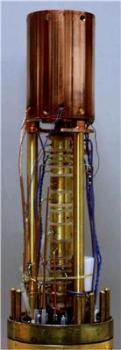For the first time, researchers have detected spin quantum jumps with an individually-trapped proton, representing a major milestone in the direct measurement of the proton’s magnetic properties with greater accuracy.
 Double-Penning trap for the storage of one individual proton and the detection of spin quantum-jumps.
Double-Penning trap for the storage of one individual proton and the detection of spin quantum-jumps.
The Helmholtz Institute Mainz (HIM) and Johannes Gutenberg University Mainz (JGU) have collaborated with the GSI Helmholtz Center for Heavy Ion Research in Darmstadt and the Max Planck Institute for Nuclear Physics in Heidelberg to perform the research.
Similar to other particles, the proton features an intrinsic angular momentum. A spin quantum jump matches a switch of the magnetic poles. Although the electron’s magnetic moment and its anti-particle have been measured, the major challenge is the direct measurement of the proton’s magnetic moment.
The main issue is that the proton’s magnetic moment is 660 times smaller than the electron and hence its detection still remains a significant challenge. The joint research team has taken five years to develop an experiment that successfully showed the detection of the proton’s spin direction.
The new research provides the required approach to directly measure the magnetic moments of the proton and its anti-particle. The anti-proton measurement is anticipated to be performed either by researchers at FLAIR/GSI in Darmstadt or CERN, the European laboratory for particle physics in Geneva.
The Standard Model of elementary particle physics implies that the behavior of particles and anti-particles are identical when inversions of time, parity and charge are applied simultaneously. If dissimilarity can be detected between the magnetic moments of anti-protons and protons, a new path would be opened in physics.